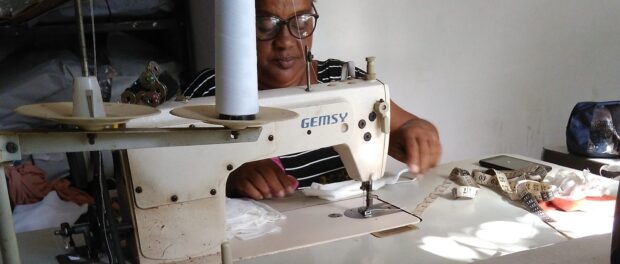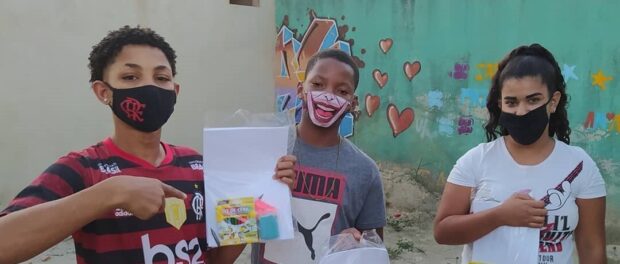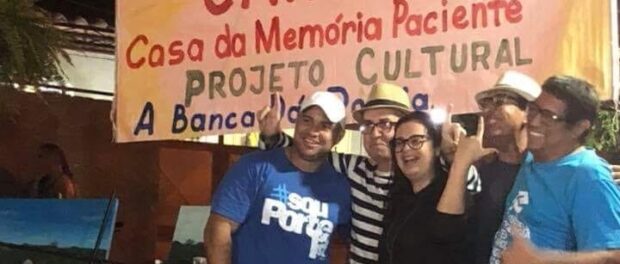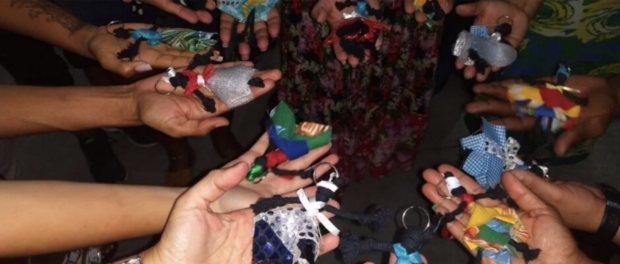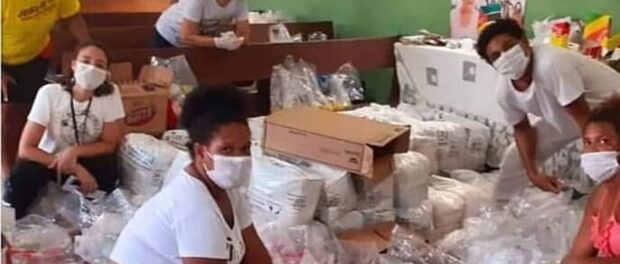
On July 22, the Historic Orientation and Research Nucleus of Santa Cruz (NOPH), through its Connected Stories project, conducted the online discussion “Sub-neighborhoods of Santa Cruz: favela communities?” The six speakers discussed how vital it is to “stop and talk” in order to reflect about the history of people, places, and moments in the neighborhood of Santa Cruz, in the distant fringes of Rio de Janeiro’s West Zone.
The debate—mediated by teacher, historian, and general coordinator of NOPH, Bruno Almeida—united sociocultural activist and scriptwriter Thiago de Jesus, who directs social projects to positively impact the favelas of Rollas and Antares; visual artist and social mobilizer Ricardo Rodrigues, member of Cerro Corá Residents in Motion; Coosturart and Cultural Space of the West Zone Cláudia Pereira; art teacher Dayane Medeiros, who coordinates the project Mission Art and Education realized by the Sustainable and Alternative Artistic Collective (CASA) in Favela do Aço; teacher and historian Guaraci Rosa, research coordinator of House of Patient Memory (Camempa); and Vice-President of the Antares Residents’ Association, Leonardo Ribeiro. Those watching included activists, cultural agitators, and residents of Santa Cruz and surrounding areas.
History, Empathy, and Recognition
The conversation included comments from local organizers about the favela communities of Santa Cruz and invited participants from other parts of the city, creating a rich mosaic of community initiatives, stories, and memories.
To open the evening, the first speaker, Jesus—who during the coronavirus pandemic has realized diverse social actions and projects in the favelas of Rollas and Dreno—highlighted the documentary that he made, The Márcias. The documentary tells the story of two residents, from the favelas of Rollas and Antares, who have in common not only the name Márcia, but also the desire to help and promote development of their communities. The Márcias acted tirelessly to help victims of flooding in their communities in 2019. Jesus explained that the documentary The Márcias has the goal of bringing visibility to these warriors and heroines, who, many times, are not seen inside or outside their community. “I went to show the reality of the people of the community, and what we went through at that moment,” he said.
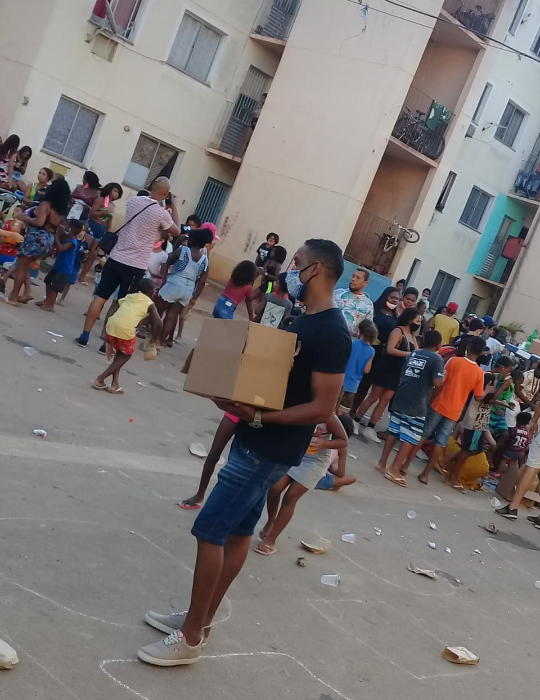 Rodrigues helped open the event and its central debate about the use of the word “favela” in the context of Santa Cruz. As an artist from the Cerro Corá favela in Cosme Velho, in the South Zone, he left clear the importance of the term favela for him. “I am the favela! I live the favela. My life is there and I don’t know how it would be to live outside of the space. Because everyone knows me, and I know everyone. If I left there to live in another favela I would feel embraced, accepted, and well-received.” He added that the definitions of the terms favela and comunidade (community) are the same, just like the social problems they face. “Between the terms favela and community I prefer to call myself a favelado, because nothing changes…In spite of the fact that I live in [a favela in] the South Zone, we have all the pains of any favela in Brazil, from the West Zone or from any other place. There is a lack of water and electricity, and sometimes there is trash in the paths and open sewage.”
Rodrigues helped open the event and its central debate about the use of the word “favela” in the context of Santa Cruz. As an artist from the Cerro Corá favela in Cosme Velho, in the South Zone, he left clear the importance of the term favela for him. “I am the favela! I live the favela. My life is there and I don’t know how it would be to live outside of the space. Because everyone knows me, and I know everyone. If I left there to live in another favela I would feel embraced, accepted, and well-received.” He added that the definitions of the terms favela and comunidade (community) are the same, just like the social problems they face. “Between the terms favela and community I prefer to call myself a favelado, because nothing changes…In spite of the fact that I live in [a favela in] the South Zone, we have all the pains of any favela in Brazil, from the West Zone or from any other place. There is a lack of water and electricity, and sometimes there is trash in the paths and open sewage.”
Rodrigues brought to the conversation his experience in the project Memories of Cerro Corá. He said that in his community “there was a girl whose brother died in the drug traffic. Before he died, he got rid of all the photos he had. But we found them and put them in the exhibit that we organized. Her emotion was contagious.” He described projects related to memory, like Memories of Cerro Corá and Rio’s favela “ecomuseums, which aren’t just in enclosed spaces, but involve the whole area, from the start of the Cerro Corá slope to Guararapes. Our biggest archive is our residents.” The visual artist was going to bring his exhibit “Favelando” to NOPH, but it was delayed due to the pandemic. In Rodrigues’s opinion, unity among local favela communities is important for all who live in Santa Cruz and surrounding areas.
Pereira, a resident of the Liberdade Housing Complex on Avenida João XXIII, in Santa Cruz, spoke about the nostalgia that the neighborhood brought for people who were raised in the West Zone. “My grandparents and my parents worked in Rádio Brás. My grandfather was compensated with a plot of land on Rua Primeira, where I spent my childhood. My father was the first black man to be a banker at BANERJ [the Bank of the State of Rio de Janeiro], and I studied at Delta High School. I know each street of Sepetiba.” With an always attentive cultural eye, after her parents separated, the social activist said she started to frequent the sub-neighborhood João XXIII: “My aunts always said, ‘Don’t go there! [The other side of] the train track is not good, don’t sit on the other side. People from Antares bring farofa [a popular Brazilian cooked manioc flour] to Carnival.”
About the labeling of favelas in the region, Pereira gave her position: “Each community has to call itself the way it thinks is best and the way it sees itself. [This decision] has to be based in liberty.” And she completed her reflections about the maturation of the region: “We are gaining the ability to exit the political axis that most sunk the West Zone. They were the Wild West of people who wanted to get elected, and disappeared. I remember when we went to FAMERJ [the Federation of Residents Associations of Rio de Janeiro], to fight for our rights.”
Culture, Art, and Education
Medeiros also focused her comments on this maturation and the role of who is “raised here”: “How [are we, residents of the region] making it so that children feel like they belong to the place? How much can we, as educators, reverse this history of growing up [with a stigma] of being a favelado from the West Zone? We have to stop and think about this. The Unified Collective for the West Zone arose during the pandemic because we knew that there would be chaos, and if help arrived for favelas in Rio, it would arrive only in the Center and the South Zone. So we have urgency to make this movement a collective one, get together, and gather our voices to say, ‘Look at us here’… Now is the time for us to arrive. We are raised here, and today we’re working with youth from Santa Cruz.”
About her decision to get involved, Medeiros says, “In 2018, with the death of Marielle Franco, and with me becoming someone who thinks about public policies, being a seed of Marielle, I thought, ‘What am I doing for my periphery? What are my eight years of struggle for me to graduate from a federal university contributing here?’” she reflected.
Perceiving the differences between favelas outside the North Zone and South Zone axis brought the teacher to found the CASA collective in 2017 in the Favela do Aço. It is a group that arose at the Federal University of Rio de Janeiro (UFRJ), formed by artists outside of the traditional circuit, with the objective of creating their own expositions. The history of resistance and occupation of Aço can be told through the removals and occupations of homes even before they were inaugurated. Medeiros explains that “there is this question of how Favela do Aço here in the West Zone axis was the first favela started here following an eviction [from elsewhere]. Afterward, there was City of God and Vila Kennedy. So it was the first surprise. The first favelado culture that arrived in Santa Cruz was Favela do Aço. There is this question of cultural shock because it was a rural area and now the group that got evicted arrived, and fell victim to prejudice, generating a low self-esteem in the community.”
Medeiros added, “we have to think about how we are creating a history with our children. Who is raised in Favela do Aço can’t say inside of a shopping mall that they are from Favela do Aço. It is our third year [of CASA] and we are going to talk about knowing the spaces, the favelas, of the West Zone. We need to change how we talk about our history. We have to reconstruct this story in the way people tell it, this story of Santa Cruz.”
In this same line of thinking, the art teacher said that prejudice affects urban mobility: “I live in Campo Grande, and if I get an Uber here at my home to Favela do Aço the Uber goes, but from the center of Santa Cruz to Favela do Aço the Uber does not enter. The residents themselves of Santa Cruz have an absurd prejudice.”
For Rosa, research coordinator at Camempa, understanding local culture should be part of the public school curriculum. “In the history books, it looks like a tourism book with the Christ the Redeemer statue, Ancient Egypt, here and there, and it’s over. The child doesn’t know the name of the river that runs by her own house. This absence [of local memory] in Santa Cruz is very significant. We have a Jesuit past, but when we enter the Republic period [of Brazilian history], Santa Cruz died.”
Rosa explains how looking to the past and thinking to the future are fundamental for thinking about public education policies that are effective for the region: “We have a major lack of studies on local history… My Grandmother was one of the first, she had land that was a rural site in the 1960s. School only [arrived] in the 1980s, a health clinic in the 1990s, there was no police station, so you had an absence of government… and all of these areas were rural. People criticize their peers who throw trash on the ground, but they do it themselves. The person who grows up without education, without infrastructure, what do you expect? An engineer, a doctor?”
“In the past we could understand the educational issue. Until the 1960s there was no public high school for the Inhoaíba and Sepetiba axes. The first school was the Barão School of Rio Branco. In the 1980s, we had to take a test to enter the school, because the authorities wanted the masses to work.”
Finally, Rosa described the strength of peripheral entrepreneurs: “Today the entrepreneurs, the autonomous workers, are appearing. The young person who is 15 or 16 who is abandoning school because he wants to work for himself, because there he sees the future… All of this you only understand when you know the history of your neighborhood. You need to understand the development process of Favela do Aço, of Rollas. The evictions. Really, the people were thrown there. The government in 1961 wanted to take out the favela. They showed the people moving to Fazenda Botafogo who had some structure, not to Vila Paciência, where there was child prostitution. The people walked from there to Paciência to access transportation. The people moved [here] from Inhaúma, they moved from the South Zone. But they continued working there. People have photos here from the 1960s. You ask yourself: how can one let a human being live in such a degraded way?”
For Ribeiro, the curiosity about the culture of Santa Cruz came when he noted his friends and family members were not part of local history. His parents were residents of Maré in the 1970s, where they lived in houses on stilts, and had jobs inside the favela itself. For five years in the Antares Residents’ Association, the young man has sought to get to know, and share with everyone, the best of the region. “Despite not being an academic historian, I always seek to research about the favelas here. When the authorities conduct evictions, it weakens all of a community and its local traditions, because it forces together many people [from different origins] into one new community,” he said.
Carnival and local industries like Gerdau are research interests for Ribeiro as he learns more about the formation of his neighborhood of Antares. Before physical distancing began, the cultural producer started a project about carnival parades in the West Zone. “I was researching that there was a carnival parade in Morro Azul, in the South Zone. In 1979 this parade occurred in Bonsucesso. It was a registered parade that was fully organized. I found this register in the National Museum, in the part about parades from Antares. I made an exhibit about the parade Unidos de Antares to commemorate 45 years in the region, because it was very close to Carnival,” he said.
Resistance
Finally, Luiza discussed the importance of African history to understand the black population in Santa Cruz and surrounding areas. “The family comes to live here and does not feel part of everything. In the process of empowerment, not everyone likes or is interested in the history of Africa. There are various challenges, and I don’t even know much myself about blackness. The challenge is to unite all members of NOPH so we can identify more with each other. We will do it!”

